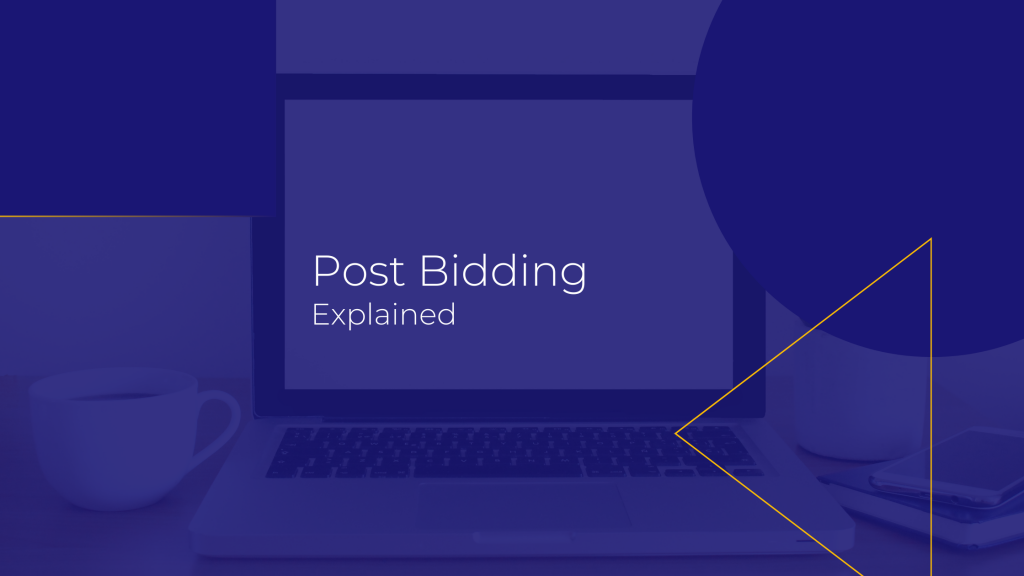The ever-evolving ad tech industry constantly offers new opportunities for growth and revenue optimization. At the same time, in a space full of buzzwords, definitions often start to blur in one’s mind. Today, we are tackling Post-Bid: find out what it is, how it works, what are the technology’s pros and cons and does it make sense to use it. If you are unsure of your understanding of header bidding and prebid, you might want to check our latest article about header bidding wrappers first.

So, What is Post Bidding?
Post-bid, post-bidding, or post-bidding are all terms used to describe the technology that lets the auction for an impression happen after the ad server has rejected all direct and exchange-based line items. The ad server has to first select the post-bid line item, in which case the winning line item’s creative is in fact a Prebid.js tag. Only after this does the actual auction among the demand sources take place. In contrast, with header bidding the opposite happens – the auction runs before the ad server has seen the impression.
How Does It Work?
First, the ad server receives an impression from the webpage. Then, it chooses the highest bid among direct-sold ads/sponsorships, exchanges, and post-bid line items. If a post-bid line item wins, then its creative content is served to the page. At the same time, this creative run a competition among the demand partners using prebid.js. The creative from the highest bidder is then displayed on that ad spot.
Advantages
Low Technical Involvement
With post-bid, you wouldn’t need deep technical skills to set it up and run it. In fact, it is as simple as running a third-party tag on your ad spot. This is one of the main reasons many publishers give it a shot – it doesn’t require the engineering resources that are much needed for header bidding integration and optimization. Among other things, in order to get the best results, header bidding would require many more line items in the initial setup than post-bid, which further increases the workload and makes post-bidding a breeze in comparison.
Reduced Latency
Another advantage of post-bid, that publishers find attractive, is that it will display the ads with no added delays. Because the ad server gets the impression as soon as the page loads, there is practically no latency. It can in fact be a better solution than the standard waterfall setup in terms of speed, as all demand sources are called at the same time.
Drawbacks
Revenue Uplift Is Not Comparable To Header Bidding
The post-bid line item has a fixed bid price (not real-time) that is based on historical data. Thus, it does not allow equal competition among header bidding demand partners and other types of demand. The lack of true dynamic allocation translates to lower revenue uplifts when compared to the gains from implementing header bidding.
Each Ad Unit Runs A Separate Post Bidding
There will be simultaneous auctions for every winning post-bid line item that is selected for the separate ad units on the page. This can lead to a browser overload as it will have to run the prebid.js code multiple times. However, the webpage content is normally already loaded, as the auction happens after the ad server has selected the line item.
Complicated Reporting
The ad server line item report will only deliver aggregated information for post-bid demand sources. Therefore, publishers can only get detailed information about their inventory from third-party reporting.
So, Should You Give Post-Bid A Shot?
If you currently don’t have the ad ops resources to set up and optimize header bidding, then you should probably opt for post-bid. This will allow you to run a competition among header bidding demand sources (although not a real-time one, thus with limited effect), and improve your revenue to some extent. To avoid blanks in the case that no demand partner wins the impression, you have the option to optimize with a fallback, say to your AdSense account, or a house ad.
Alternatively, if you want to go for a higher revenue uplift without investing in more ad ops and dev, you can utilize header bidding’s advantages via a managed solution. Get in touch with us, if you would like to discuss the options for your website.

